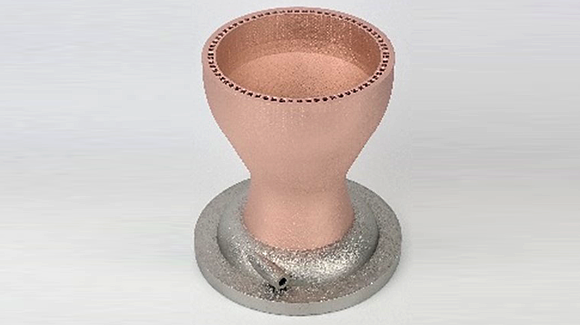JAMPT aims for critical role in Japan’s adoption of AM
November 19, 2021

Specialist service bureaux in Japan often act as the first step on the Additive Manufacturing journey for manufacturers, allowing companies to visualise operations before introducing an in-house system. One such bureau is Japan Additive Manufacturing & Processing Technology (JAMPT), based in Tagajō in the Miyagi Prefecture.
JAMPT was one of the country’s first specialist metal AM service bureau to provide technological services, from metal powder development and prototyping to mass production. The company works closely with aerospace, defence, medical equipment, and automotive sector manufacturers who are planning to deploy metal AM technology.
As the use of metal AM grows internationally, spurred on by successes with part consolidation and lightweighting, JAMPT’s Plant Manager Shoichi Sato believes that some industries in Japan are still catching up. “While aerospace companies in the US and other countries are installing metal additive components into aircraft engines, here in Japan, we are still often faced with helping and educating companies how to identify the possible benefits of the technology,” stated Sato.
“If you take a snapshot of Japanese industry, it is the defence industry – thanks to support from the Acquisition, Technology & Logistics Agency (ATLA), part of the Japanese Ministry of Defense – that is currently progressing further than other industries, in terms of the technological and practical use of Additive Manufacturing,” he explained. “However, there are encouraging developments underway in the medical equipment industry and the automobile industry, and the number of successful cases and new requirements are progressively growing, little by little.”
Sato added, “In terms of the adoption of metal additive here in Japan, it has become clear that there are specific issues in each industry. Identifying and then solving them will lead to the growth of the Additive Manufacturing market. We think we have a good opportunity here at JAMPT, to play an important role and contribute to the additive manufacturing industry as it develops.”
One of the many projects that JAMPT has been involved in includes a recent project with JAXA, the Japanese national aerospace and space agency.
“We took part in a project to manufacture components for KOUNOTORI, the unmanned cargo transfer spacecraft for the International Space Station that completed its mission in 2020,” Sato explained. “JAXA wanted to additively manufacture the attitude control injection nozzle, because conventional machining was problematic in terms of the manufacturing time and weight. During the development of this thruster part, we recommended using Ti6Al4V powder and GE Additive’s [PBF-EB] technology.”
Using the Electron Beam Powder Bed Fusion technology, Sato and the team were said to have reduced the manufacturing time for the nozzle by 60%, decreased part weight by 64% via topology optimisation and improved material lead by more than 30% compared to of conventional manufacturing.
JAMPT supports many companies across a wide variety of industries in introducing metal Additive Manufacturing and as a specialist service bureau, has used its metal AM machines to form many shapes that had been previously thought either impossible or difficult to form. JAMPT is also engaged in R&D to improve the quality of the AM products, and is currently conducting the predictive and inverse design of residual stress and deformation volumes by compensating residual stress analysis results using experimental data, as well as conducting repeated parameter optimisation tests using the experimental design method and other ways to control defects due to the forming parameters.
In addition, JAMPT has acquired JIS Q 9100 certification – a quality management system required by manufacturers in the aerospace and defence industries in Japan, equivalent to the AS 9100 standard used in North America and the EN 9100 standard in Europe.
In the automotive sector, JAMPT has formed a technical partnership with the research institute Tokyo R&D Co., Ltd., to provide a Design for Additive Manufacturing (DfAM) support programme for automobile manufacturers. The partnership provides various services, including proposals for the use of AM in automotive, as well as services for other industries, such as structure and strength analyses to manufacture lightweight jigs, tools, and thermal fluid analyses for the thermal management of coils and heatsinks.
Sato concluded, “As the adoption of metal 3D printing among our various manufacturing communities, the demand for specialist metal 3D printing service bureaus in Japan is increasing. If you are getting started, encountering challenges with additive manufacturing, please contact us. Let us seek solutions together using our metal additive technology and apply the expertise and know-how that we have developed.”
JAMPT was established through a joint investment between Koiwai Co., Ltd.; Tohoku University Venture Partners Co., Ltd. (THVP-1 fund), and the Sojitz Corporation. Koiwai’s activities involve the advanced technical and functional aspects of metal AM, process control and quality control during the development, manufacturing, test production, and mass production of metal powders. Professor Akihiko Chiba of the Institute for Materials Research at Tohoku University, supports from an academic point of view, while Sojitz manages and operates the business using its global network, information collection and analysis capabilities.
JAMPT runs a total of seven Electron and Laser Beam Powder Bed Fusion (PBF-EB and PBF-LB, respectively), with GE Additive’s Concept Laser M2 the most recent addition.
















